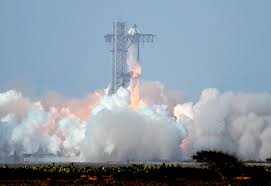SpaceX lost control of its Starship rocket just 30 minutes into its ninth test flight on Wednesday, leading to the vehicle’s disintegration during reentry into Earth’s atmosphere, the company confirmed.
The failure occurred after an onboard fuel leak triggered an uncontrollable spin, forcing Starship to re-enter the atmosphere earlier than planned. The spacecraft ultimately experienced what SpaceX referred to as a “rapid unscheduled disassembly,” or break-up.
Despite the setback, SpaceX emphasized the value of the mission. “With a test like this, success comes from what we learn,” the company said in a social media statement. “Today’s test will help us improve Starship’s reliability as SpaceX seeks to make life multiplanetary.”
Standing at 403 feet (123 meters), Starship reached a farther distance than in previous attempts before malfunctioning. The rocket is central to Elon Musk’s ambitious plans to transport humans to Mars and to support NASA’s upcoming lunar missions.
Wednesday’s launch marked the second major incident this year. On March 6, another Starship vehicle exploded shortly after takeoff. That failure prompted the U.S. Federal Aviation Administration (FAA) to temporarily suspend air traffic around several Florida airports, including Miami International, due to falling debris.
Ahead of the latest launch, the FAA expanded the restricted airspace zone to 1,600 nautical miles to safeguard against any fallout. The mission required coordination with aviation authorities in the UK, Mexico, Cuba, the Bahamas, and the British territory of Turks and Caicos.
While SpaceX continues to invest billions into Starship’s development, the program has drawn increasing scrutiny. Environmental and regulatory concerns have mounted, with debris from previous launches discovered across the southern U.S. and the Caribbean.
Of the rocket’s nine integrated test flights atop its Super Heavy booster, four have succeeded while five—including the latest—have ended in explosions. The company remains committed to its “fail fast, learn fast” development model but acknowledges that progress “won’t always come in leaps.”
The FAA recently approved an increase in SpaceX’s annual Starship launches from five to 25, concluding that the higher frequency would not significantly harm the environment. This decision came despite opposition from conservation groups.
The program’s regulatory path has also come under political scrutiny. In March, the Campaign Legal Center filed an ethics complaint with the U.S. Department of Transportation’s Office of the Inspector General, calling for an investigation into potential conflicts of interest involving Musk’s satellite company, Starlink, and federal aviation authorities.
Musk, who has played an increasingly visible role in former President Donald Trump’s second administration, has defended his ventures as essential to rooting out what he describes as “hundreds of millions of dollars of fraud and abuse” in government spending.
Despite ongoing challenges, SpaceX continues to push forward with its goal of making Starship the most powerful and versatile spacecraft ever built.
Nzubechukwu Eze









